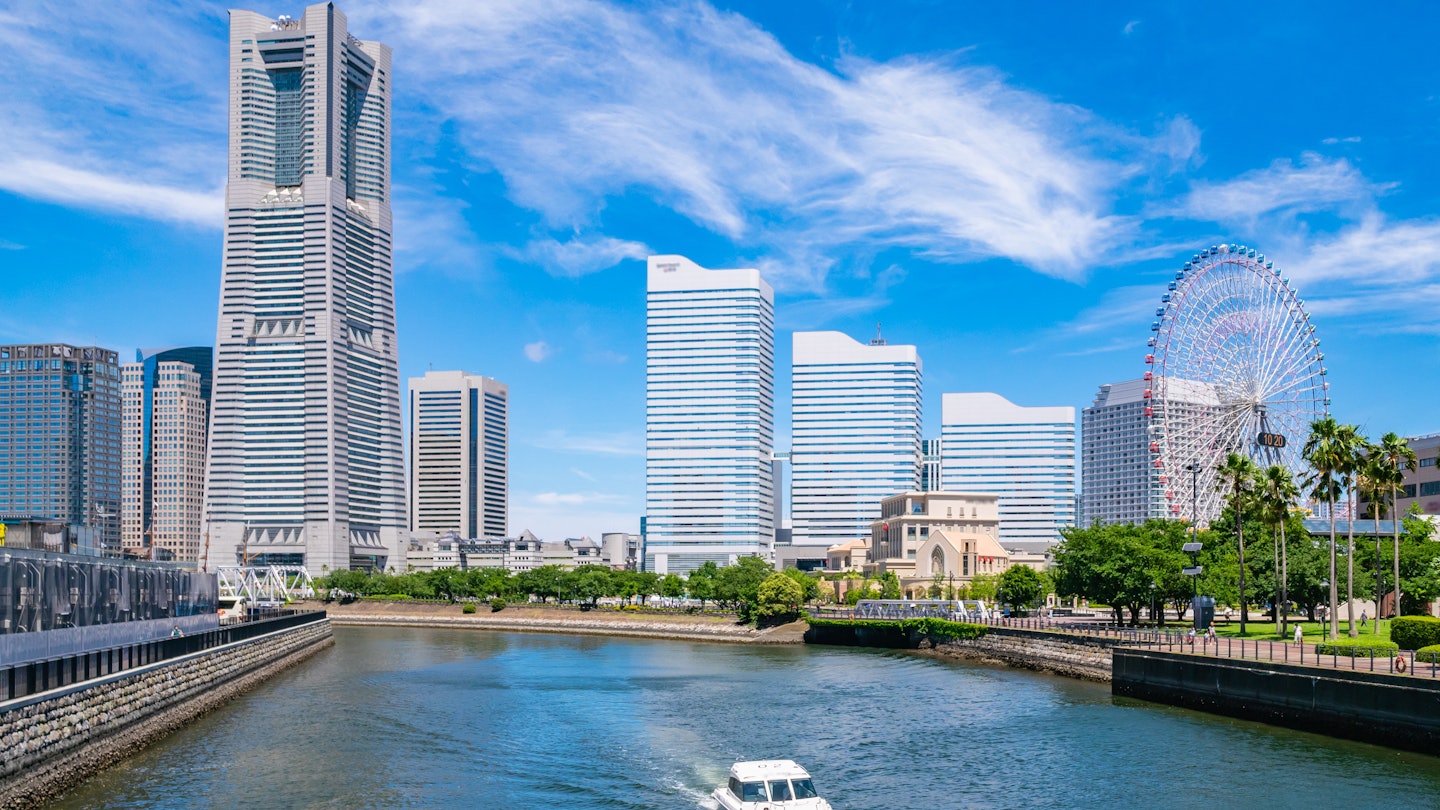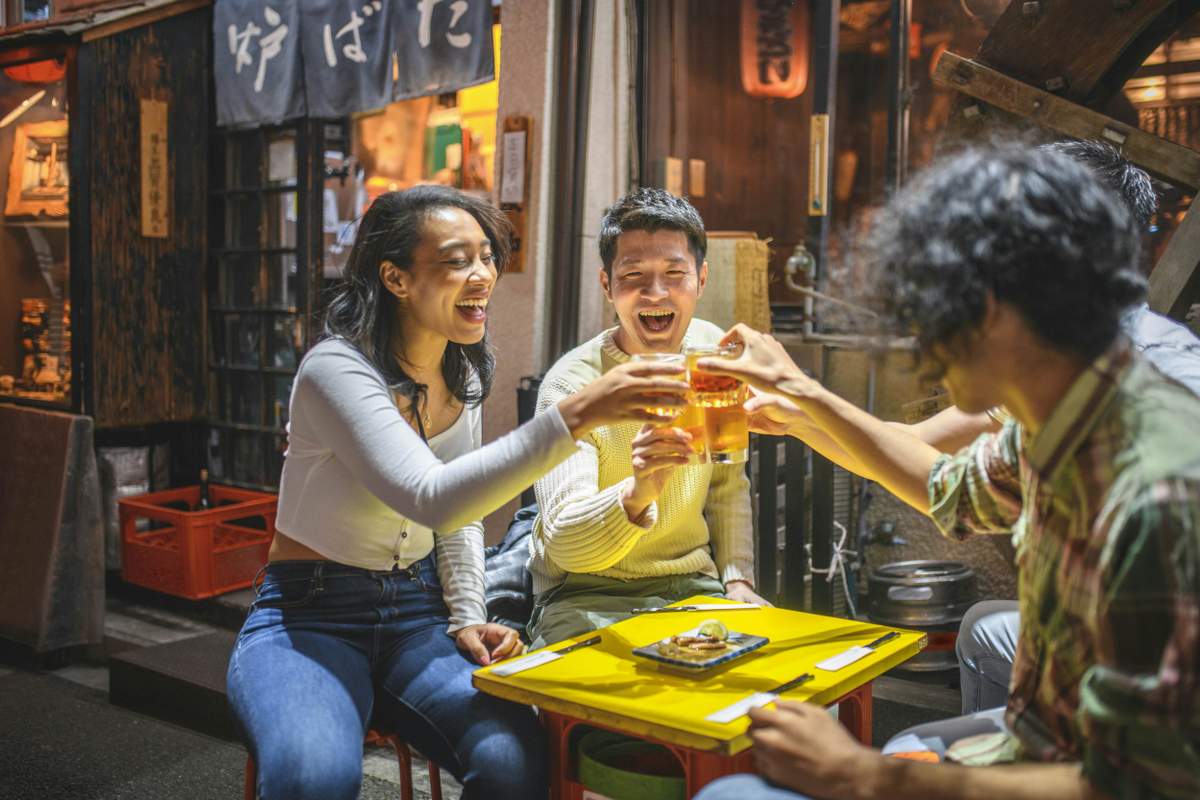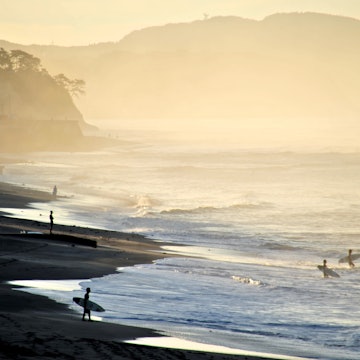

Minato Mirai waterfront district, Yokohama. okimo/Shutterstock
Many people miss out on Yokohama (横浜) because they don’t realize how amazing it is. Just a 30-minute train ride south of central Tokyo, Yokohama has an appealing flavor and history all its own. It's where the country's first foreign trading port, Chinatown, English-language newspaper, beer factory and railway station were established, and this cosmopolitan past lives on in Yokohama's creative arts and jazz scene and the sleek converted red-brick warehouses of Minato Mirai.
Drifting through Yokohama’s bayside parks, there is still a sense of a seaside town. And, despite its size, the city is easy to navigate. Locals are likely to cite the uncrowded, walkable streets or neighborhood atmosphere as Yokohama's main draws, but for visitors it's the variety of attractions and cheaper accommodations than Tokyo for the same level of quality.
Here are the 13 best things to see and experience in Yokohama.

1. Discover Yokohama's maritime history aboard the Nippon Maru
The Nippon Maru was originally used as a training vessel for Japan's merchant marine. During its years of service, 11,500 cadets were trained on board and the ship logged over 1.8 million kilometers of sailing distance – enough to circle the globe 45 times. It's now permanently docked in its own memorial park in Minato Mirai. You can board the ship for tours and view its 29 sails unfurled on special occasions several times a year.
Adjacent to the Nippon Maru is the Yokohama Port Museum, where you can walk through a chronological history of Yokohama Port and its influence on the development of the city.
Detour: The NYK Hikawa Maru, docked at the southern end of Yamashita Park, is a cargo-passenger liner that traveled between Japan and Seattle more than 250 times. As the only surviving pre-WW2 passenger liner, this is a must-see vessel for maritime buffs.

2. Enjoy ramen or make your own at two museums
If you love ramen, Yokohama is the place to be, with two fascinating ramen-related museums.
Dubbed a "ramen-themed amusement park," the Shin-Yokohama Ramen Museum near the Shin-Yokohama Shinkansen station has eight ramen shops representing regional styles from across the country, allowing you to sample different flavors and ingredients. There’s also a small museum about the history of ramen, a ramen noodle–making workshop (make reservations in advance) and a Ra-haku Sugomen Lab experience where you can design your own instant ramen container and ingredients to take home as a souvenir.
But the real fun comes from the surroundings. The Shin-Yokohama Ramen Museum is designed as a nighttime streetscape of 1958 downtown Yokohama, immortalizing the nostalgic feel of the city. That was the year Momofuku Ando invented the world's first instant ramen, Chicken Ramen, which helped make ramen famous around the world. (He later went on to invent CUPNOODLES in 1971.)
To pay tribute to the invention that helped millions of college students survive dorm life, also visit the CUPNOODLES MUSEUM, located opposite Yokohama Cosmo World. In addition to a museum dedicated to Momofuku Ando, you'll find instant ramen–making workshops.

3. Appreciate traditional Japanese architecture and landscape at Sankeien Garden
Because Yokohama started as a humble fishing village, you won't find former samurai residences transformed into public parks here like you do in Tokyo. But you can enjoy Sankeien Garden, a gift to the citizens of Yokohama from the fabulously wealthy Sankei Hara, who made his money as a silk merchant in the early 20th century.
Hara used much of his fortune building Sankeien to share with the public. He painstakingly brought many famous buildings here from other parts of Japan, some of which were owned or designed by Japan's most powerful historical figures – like the nearly 600-year-old three-story pagoda from Kyoto's Tomyoji Temple, which was relocated here to enhance the view.
Local tip: Sankeien Garden is gorgeous in the spring, with many types of cherry trees framing its historical buildings with pink-petaled blooms. Architecture and history lovers will enjoy seeing the buildings any time of the year.
4. Drive a train at the Hara Model Railway Museum
Surprisingly devoid of tourists, the Hara Model Railway Museum is a charming museum located near Yokohama Station that was the labor of love of Nobutaro Hara, one of the world's most prolific collectors of model trains. While a brief section of the museum focuses on Hara, who died in 2014 at 95, the majority is dedicated to his immense collection of 6,000 model trains, which he built over years of international travel.
The museum's highlight is its Gauge 1 model railway diorama, the largest in the world. Models run on six iron tracks, draw electricity from overhead lines and look and sound like authentic trains. Visitors are encouraged to explore the diorama's detailed scenes by going on a mini treasure hunt, searching for secrets contained within it.
But most fun of all, you can drive one of the model passenger trains. A limited number of five- to 10-minute minute slots are offered daily, during which you can operate a model train using authentic controls and learn how to make a perfect stop on the train platform.
Detour: For an up-close look at life-sized trains, visit the nearby Keikyu Museum, which explores the Keikyu Group's transportation business. Try out the train simulator or board a Deha 236 train car at a station designed like the 1970s.

5. Shop and dine in historic Akarenga Soko
There's plenty of shopping in the Minato Mirai area, but no place blends the ambiance of Yokohama's romantic past with shopping and dining experiences like the Akarenga Soko red brick warehouses along the waterfront. Used for customs inspections in the early 20th century, these three-story buildings now contain a dozens of unique shops, restaurants, galleries and a performance space. The wide plaza between the two buildings is often used for seasonal events, including a popular ice skating rink in the winter and food festivals throughout the year.
Local tip: The recently constructed Yokohama Air Cabin can whisk you between nearby Unga Park and Sakaragicho Station in a mere five minutes. You can, however, walk between the same destinations in about 10 minutes, making the ¥1,000 (US$7) adult fare feel steep.

6. Taste Chinese culture in Yokohama Chukagai
Along with those from the rest of the world, Chinese traders took advantage of the opening of Japan's ports in the mid-1800s. They established Japan's largest Chinatown in the area adjacent to Kannai, home to foreign residents from America and Europe. As local Chinese people became more affluent, Chinatown evolved, with gourmet restaurants, tailors and barber shops becoming prominent businesses.
That rich history, especially in Chinese cuisine, is still prevalent in Yokohama Chinatown, officially known as Yokohama Chukagai. Today there are over 10 blocks filled with 600 specialty shops and restaurants, some down intriguing alleyways. There are 10 beautifully painted gates dotted throughout, with the main Zenrinmon Gate standing tall at the west entrance of the main pedestrianized strip.
You’ll also want to visit Mazu Miao Temple, an extravagantly decorated Taoist temple that is a visual riot of color and design. Equally impressive is Kanteibyo, a Buddhist temple that is especially stunning at night when the exterior is lit up by lanterns. Inside the temple, be sure to admire the detailed roof dioramas and stunning ceiling.
Planning tip: The best time to visit Yokohama Chinatown is during Chinese New Year, when the streets buzz with lion dances and other celebratory events.
7. Swing to the beat of Yokohama jazz
Yokohama has a rich and vibrant jazz scene that pulses throughout the city. One of the highlights is the annual October Yokohama Jazz Promenade, Japan's largest jazz festival. The festival draws over 100,000 people and features more than 2000 jazz artists across 50 venues around the port town. The smaller Asahi Jazz Festival in late August is also worth a visit for jazz lovers.
For a taste of everyday jazz, head to Bar Bar Bar, one of the oldest and biggest jazz clubs in Yokohama with 40 years of history. Musicians like Wynton Marsalis and Salena Jones have performed here. At Ben Tenuto, you’ll be greeted by a cute robot called “Ben-chan.” The spot is casual but has a great piano soundscape, good food and a reasonable cover charge.
Or, if you're looking for a cozy, lounge-like experience, step into Jazz Bar Venus, a laid-back venue where small combos, like vocal and piano duets, perform every night. The staff are young aspiring talents themselves, and the friendly atmosphere makes it easy to meet locals.

8. Ride one of the world's fastest elevators up Landmark Tower
The view from the 69th floor observation deck of Yokohama's Landmark Tower is one of the best in the country, with its bird's-eye view of the Yokohama Minato Mirai waterfront and a panorama that stretches from the distant skyscrapers of Tokyo to majestic Mt. Fuji.
However, for some, the speed with which you reach the observation deck is most remarkable. Zooming up 296 meters (792 feet) in just 24 gut-wrenching seconds, the elevator reaches speeds of 45kph (28mph).
Planning tip: The best views and largest crowds appear around dusk, so time your visit accordingly.
9. Beautify body and mind at Shiseido Beauty Park
You might not expect to visit a major cosmetics company while traveling, but Shiseido Beauty Park does not disappoint. The main attraction is the second-floor Shiseido Art & Science Lab, an interactive museum that demonstrates not only the science behind Shiseido's products but also the unique appeal of their packaging – a hit for anyone interested in product design.
Its Beauty Retreat Theater presents a multimedia experience that uses a high-definition display covering an entire wall, noise-canceling headphones and luxurious chairs to provide a short but relaxing experience. You can watch the movie from anywhere but need a reservation to experience it from the special seats. (Reservations are free and taken in first-come, first-served order; write your name on the reservation sheet when you arrive.) If you’re hungry, the Shiseido Kitchen Lab serves exquisitely plated meals made with ingredients said to promote beauty, health and mental clarity.
Detour: If you have a few extra hours and ¥30,000 (US$200) to kill, you can book a three-hour Beauty Diagnosis Lab session, which uses seven types of measurements to evaluate your skin, body and mind and create a report to help you develop lifestyle habits and skincare practices that are best for your condition.

10. Enjoy a draft at the Kirin Beer factory tour
Kirin makes one of Japan's favorite draft beers, and Yokohama is home to one of the factories that produces it. Although the factory tour is offered only in Japanese, it is interactive enough to be enjoyable even if you can't understand every detail. And at end you'll get treated to a tasting session, where you can sample two or three of the brewery's beers. There is also a beer hall connected to the brewery that serves meats and other dishes with ingredients from Kanagawa Prefecture that pair well with beer.
Planning tip: Reserve your tour in advance and be sure to cancel if you can't make it or the brewery may not let you schedule in the future. The Kirin Brewery is about a 10-minute walk from Namamugi Station on the Keikyu Line or about 20 minutes by taxi from Yokohama Station. Walk or take public transportation if you plan to imbibe.
11. Cheer the champs at Yokohama Stadium
Downtown and easily accessible from other attractions around Yokohama Station and Minato Mirai, Yokohama Stadium is home to the Yokohama DeNA BayStars, an underdog team that became league champions in 2024. Local pride and excitement around the BayStars guarantees an electric atmosphere at every home game. And fans from home and visiting teams have unique cheers for each player, which go on throughout every inning, not just at exciting moments.
You can purchase advance tickets online (in Japanese only) or on game day at the stadium, but keep in mind you can't buy game day tickets with credit cards and there is a decent chance the game will be sold out. Food and drink at the stadium is reasonably priced, and the quality and variety will impress you.
Detour: If you prefer soccer over baseball, the J-League team Yokohama F. Marinos plays at Nissan Stadium near Shin-Yokohama Station, while the rival Yokohama FC plays at NHK Spring Mitsuzawa Stadium.
12. Soak or steam away your weariness at Sky Spa
With so many things to see and do in Yokohama, you may find yourself looking for a spot to relax and soothe your tired feet. Sky Spa is located on the 14th floor of the Sky Building, a five-minute walk from Yokohama Station. Designed for young remote workers who prefer mixing relaxation and work time, Sky Spa contains several types of saunas, hot springs baths, restaurants and co-working spaces and is open 24 hours.
There are also a variety of spa treatments available. If you can't bear to leave, capsule-like accommodations for individuals are available for overnight reservations.
Detour: Yokohama Manyo Club offers a similar experience without the saunas and co-working spaces but with views of the Minato Mirai waterfront district. Onsen mineral water for the baths is transported daily from famous onsen areas Atami and Yugawara.

13. Connect with your inner artist at one of Japan's largest art museums
The Yokohama Museum of Art was designed by renowned architect Kenzo Tange and has an enormous collection from Japanese and international artists. Within its nine exhibition rooms and the Grand Gallery atrium, the museum holds special exhibitions as well as rotations of its own vast collection.
Fully reopened in February 2025 after a major renovation, the museum has something for art lovers of all ages, including workshops for children and adults and an immense art library containing over 200,000 media, including books, periodicals and exhibition catalogs.
Planning tip: Every three years, Yokohama Museum of Art becomes the epicenter for the Yokohama Triennale, a citywide contemporary art event featuring established and emerging artists from around the world. The next event is scheduled for 2027.
















